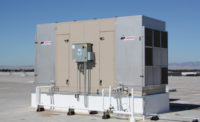A new HVAC design is expected so save an estimated $918,000 at the REC community center in Grapevine, TX. The savings is projected in operational and energy costs over the heating, cooling, and dehumidification units’ expected 25-year lifecycles.
The savings will result from design options and high-efficiency equipment choices, such as an energy-recovery indoor pool dehumidifier, condensing boilers, high-efficiency chillers, and other energy-efficient selections, according to Bert Baiotto, P.E., principal with The Ballard Group in Lakewood, CO.
Specifying a cooling/heating hydronic four-pipe loop design for the 114,000-sq-ft project enabled The Ballard Group to use cooling and heating coils in air handling equipment, as opposed to individual direct expansion (DX) methods. For example, the 18,000-sq-ft natatorium’s 125-ton, 40,000-cfm NW-Series rooftop dehumidifier, manufactured by Seresco USA, dehumidifies, cools, and heats the space with factory-installed coils. Instead of an integral DX refrigeration circuit, the coils are economically supplied by the facility’s three high-efficiency, air-cooled 200-ton chillers manufactured by York and two 3,000-Mbh condensing boilers by Lochinvar.
The extra capacity enabled converting the adjacent 48,000-sq-ft library’s existing 15 packaged rooftop units from DX to chilled water/heating coils, which will also significantly reduce the city’s HVAC maintenance costs. All the equipment contributes to the aforementioned $918,000 savings, which is estimated by Group 14 Engineering, the project’s third-party energy modeling and equipment optimization contractor.
Furthermore, The Ballard Group’s specification of a dehumidifier with chilled/hot water coils supplied by central plants also saved Grapevine approximately 25% in equipment capital costs versus a DX model.
“The energy savings and the unique design make the REC one of the top municipal rec centers in Texas,” said Chad Hester, BOMI-SMA, facility manager for the City of Grapevine.
The natatorium is a hybrid of waterpark and community pool designs. The high evaporative rates of the many aquatic features combined with Texas’ excessive humidity made it one of The Ballard Group’s more challenging projects in terms of psychrometric calculation and dehumidifier sizing. Some of the features generating high evaporative rates include an 84°F lazy river; 12 by 12-ft, 102°F spa; a 60 by 60-ft free-form island featuring sprayers, water cannons and a dumping bucket; and two 150-ft-long water slides where 70% of the runs travel outdoors before dumping into the play area for kids.
Baiotto calculated the significant indoor evaporative rates and outdoor air humidity loads to size the dehumidifier to remove a capacity of 712 lbs /hr. He used proprietary psychrometric software developed by The Ballard Group, who has designed 237 recreation centers the last 10 years throughout the central states. Eighty percent of those projects include natatoriums.
“In a waterpark type atmosphere, it’s critical to assure there’s enough tonnage to keep the relative humidity in check,” said Baiotto. “Because of the higher design water temperatures and the higher evaporative effect of the water features, the natatorium required approximately 125% more dehumidification capacity than a typical community indoor pool of similar size.”
Another energy-saving design feature is the dehumidifier outdoor air sequencing that The Ballard Group specified for the facility’s citywide TAC BMS and accompanying StruxureWare software, both manufactured by Schneider Electric. On normal days, natatorium outdoor air is approximately 25% of the supply air, which slightly surpasses ASHRAE’s 62.1 Standard of .48-cfm/sq ft of pool surface and deck area. The extra outdoor air carries a slight energy penalty but ensures a superior IAQ. However, the dehumidifier’s outdoor air sequencing can also automatically maximize to 50% during Texas’ inherently cool and dry winter season at a significant energy savings. The sequencing shuts off the microprocessor-controlled supply valves to the chilled water coils and automatically opens dampers to control natatorium dehumidification with cool, dry outdoor air.
The Ballard Group also specified the dehumidifier for heat recovery. Heat from the exhaust air preheats outdoor air from ambient to near supply air temperatures at a reduced energy expense. For example, using free heat recovery for preheating outdoor air from 30°F to 55°F on a winter day saves significant energy costs versus heating totally from fossil fuel-based systems.
While the natatorium IAQ is superior, Hester, with the technical help of Seresco’s manufacturer’s representative, Texas Air Systems, critically reviews the space periodically for possible tweaks. For example, Hester plans to increase the natatorium exhaust fan control set point from -0.05 w.g. to -0.1, in order to increase the natatorium’s critically important negative. The relatively low -0.05 w.g. was an energy saving measure; however, Hester said variances in atmospheric pressure, outdoor wind direction/velocity, adjacent interior positive pressure spaces, and simultaneous door openings sometimes skew the tightly kempt tolerance.
By accessing the software through the internet, he can circumvent a service call by resetting the dehumidifier remotely or onsite before IAQ degrades in the natatorium.



